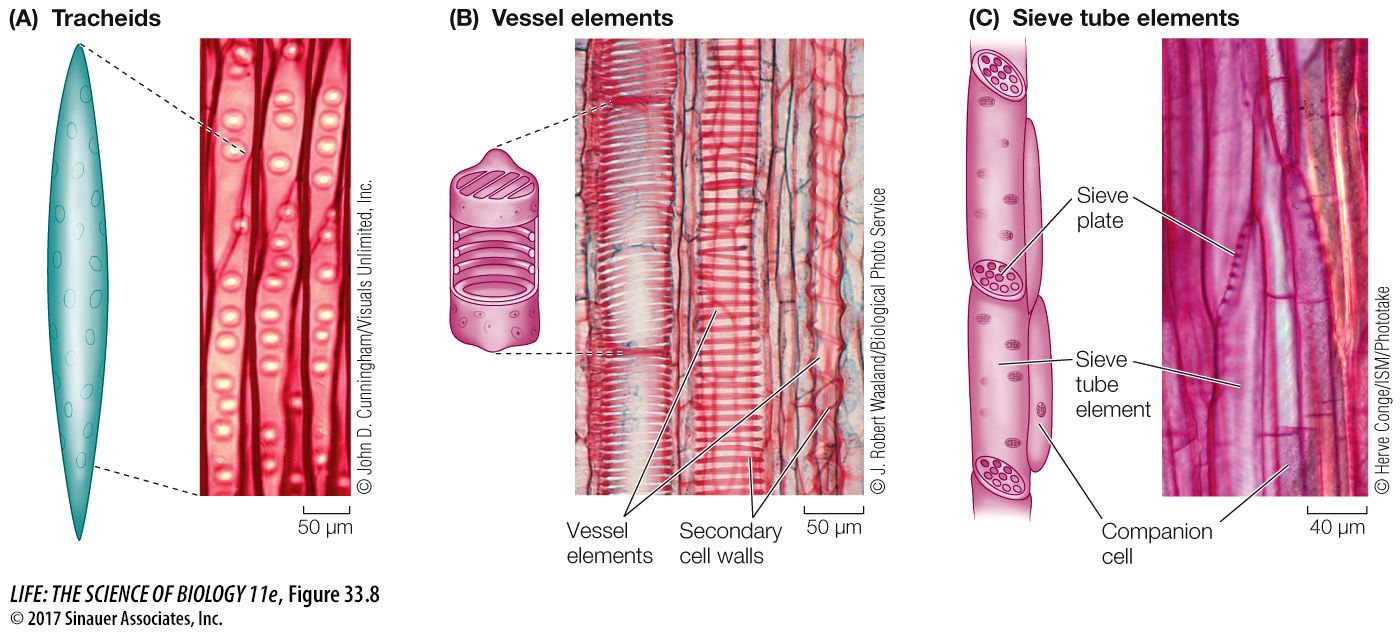The vascular tissue system develops into the plant’s transport system
The vascular tissue system is the plant’s plumbing, or transport system—the distinguishing feature of vascular plants. Its two constituent tissues, the xylem and phloem, distribute materials throughout the plant. The xylem distributes water and mineral ions taken up by the roots to all the cells of the stems and leaves. Phloem performs a variety of functions, including transport, support, and storage. The phloem plays a particularly critical role in supplying the energy-rich molecules and chemical building blocks needed by all living cells of the plant body. The phloem transports carbohydrates away from the sites of production, which are called sources (primarily leaves), and delivers them to sites of utilization or storage, called sinks. Sinks include growing tissues, storage organs, and developing flowers.
Let’s take a closer look at the structures of the diverse cell types that make up these vascular tissues. In Chapter 34 you’ll see how they transport water and materials throughout the plant body.
XYLEM TISSUE Xylem tissue contains conducting cells called tracheary elements, which have secondary cell walls and undergo apoptosis before assuming their function of transporting water and dissolved minerals. There are two types of tracheary elements: tracheids and vessel elements. The spindle-shaped tracheids (Figure 33.8A) are evolutionarily more ancient than vessel elements and are the major cell type in the wood of gymnosperms (major groups of gymnosperms are covered in Key Concept 28.2). When tracheids die, their internal components disintegrate and pits remain between the cells. Pits are cavities in secondary walls, arranged such that pits of adjacent cells are situated across from each other. Water and minerals move rapidly from one cell to another because these substances need to cross only one thin extracellular barrier, the primary cell wall.

Figure 33.8 Vascular Tissue Cell Types (A, B) Tracheary elements: (A) Tracheids in pinewood. The thick secondary walls are stained dark red. (B) Vessel elements in the stem of a squash. The secondary walls are stained red; note the different patterns of thickening, including rings and spirals. (C) Sieve tube elements and companion cells in the stem of a cucumber.
Flowering plants have evolved a water-conducting system made up of vessels, which are formed from individual cells called vessel elements. These cells are laid down end-to-end. Like tracheids, vessel elements have pits in their cell walls, but their pits are generally larger in diameter than those of tracheids. Before they undergo apoptosis, the end walls of vessel elements partially break down, forming a continuous hollow tube that functions as an open pipeline for water conduction (Figure 33.8B). In the course of angiosperm evolution, vessel elements have become shorter and wider, and their end walls have become less oblique and less obstructed. These adaptations have presumably increased the efficiency of water transport through the vessels. The xylem of many angiosperms includes both tracheids and vessels.
PHLOEM TISSUE The transport cells of the phloem, unlike those of the mature xylem, are living cells. In flowering plants the characteristic cells of the phloem are called sieve tube elements (Figure 33.8C). Like vessel elements, these cells meet end-to-end. They form long sieve tubes, which transport carbohydrates and many other materials from their sources (usually leaves) to tissues that consume or store them (for example, roots).
Whereas the end walls of vessel elements break down to facilitate flow through the vessels, the end walls of sieve tube elements form tunnels through which carbohydrates and other needed substances flow. The end walls of sieve tube elements are called sieve plates. Although the sieve tube elements remain alive, some of their components, including the nucleus, ribosomes, and vacuole, break down during development. The sieve tube elements are, however, closely connected via plasmodesmata to companion cells—specialized parenchyma cells that retain all their organelles and function as “life support systems” for the sieve tube elements.
